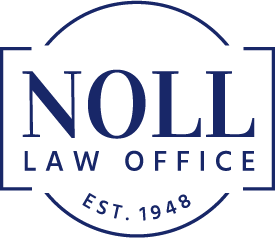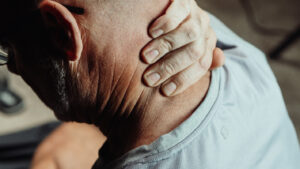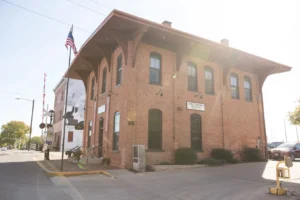Common Injuries After Car Accidents
Did You Suffer Personal Injuries from a Car Accident in Springfield? Call the Noll Law Office in Springfield, Illinois for Help
Motor vehicle accidents are one of the leading causes of accidental injuries and death in the United States. Although most types of motor vehicle collisions are preventable, unfortunately far too many people, businesses, and government entities act in a reckless, careless, and outright negligent manner. This means that most people who suffer injuries from car accidents in Springfield suffer avoidable and needless injuries. If you or a loved one have suffered any type of significant, disabling, or catastrophic personal injury after a motor vehicle wreck, call the experienced car accident lawyers in Springfield, Illinois at the Noll Law Office.
Their personal injury law firm is dedicated to representing victims and their families who have suffered pain and suffering, lost wages, unexpected medical bills, and other damages as a result of a negligent car accident. They offer FREE case evaluations where you can ask questions and get answers about your case, your rights under Illinois law, and how they can help you. Although many bodily injury law firms assign cases to lawyers fresh out of law school, the compassionate car accident lawyers at the Noll Law Office personally handle your cases from the initial consultation through trial. That means when you come to or call their office, you are speaking with a local, experienced attorney who will be handling your case.
To learn more about your rights and the common injuries from car accidents in Springfield, Illinois that the Noll Law Office can handle for you, continue reading and call them to schedule your free consultation at (217) 414-8889.
Why All Injuries from a Car Accident Need to Be Reviewed by a Lawyer
After a car accident, you may have a slight soreness or minor headache that you might ignore. Maybe you even went to the doctor and had a cast for a broken bone which healed “100%” without an issue. Or maybe you were diagnosed with a “mild” or “minor” injury, and you don’t think you should seek a lawyer’s advice for your case.
That could be a mistake.
Some of the most catastrophic, disabling, and even fatal personal injuries from car accidents start as soreness or a minor headache. Take a neckache or backache for example, which might seem mild now but could continue to worsen over the days, weeks, and months after an accident. Many victims who believe they only had a minor neckache or backache after a car accident may find themselves needing physical therapy, losing time from work, needing surgery, or even having a type of spinal fusion surgery that is permanent and irreversible. Any type of cervical fusion or lumbar fusion is a very serious surgery that can start out as a backache and turn into a life-changing injury.
The same is true for a minor headache, which could be a sign of a light brain bleed. But left untreated, a brain bleed could result in permanent damage to the brain or wrongful death. This highlights the fact that even a “mild” or “minor” injury could be devastating. There is no such thing as a mild brain injury. Any time you have suffered any type of injury from a car accident, call the Noll Law Office’s car accident lawyers in Springfield, Illinois for a free case evaluation to learn more about your rights.
Common Injuries from a Car Accident
While every car accident is different, there are certain injuries that are seen more often than others.
Most car accident injuries are minor. They include “whiplash” type symptoms, with sore muscles, a headache, stiffness, and minor loss of muscle strength or range of motion for a few weeks or months. These strains and sprains are typically low-grade and may be accompanied by bruising, swelling, and other soft tissue symptoms. Occasionally, the force of impact causes the head to snap back and forth, causing a concussion. Other times minor cuts and lacerations occur, causing the need for cleaning and/or stitches.
However, personal injuries from a car accident can be much more severe than just a strain and sprain. And some types of strains and sprains can lead to more significant injuries later. They could also be misdiagnosed for other conditions which are more severe and could result in catastrophic personal injuries. Some of the most common types of personal injuries where victims should always call a car accident lawyer like those at the Noll Law Office include the following:
Traumatic Brain Injury (TBI)
According to the CDC, auto accidents are among the most common causes of traumatic brain injuries in the United States. The impact of the accident can cause the brain to strike the hard bone of the skull in a coup-contrecoup injury. In turn, this can damage brain structures, tear nerve tissues, and disrupt the brain’s chemical and communication processes. Other types of powerful impacts can even tear brain tissue and cause significant, permanent, disabling, and life-threatening injuries. A traumatic brain injury can also cause impaired motor function.
The most common types of TBIs that may be caused in a car accident include the following:
There are many different types of traumatic brain injuries that may be caused by a motor vehicle accident in Illinois. Some of the most common include the following:
- Concussions – this type of TBI is a shock to the brain caused by a jolt, impact, whiplash, or another violate force to the head or body. Although most people believe concussions are not serious, even one concussion can have a lasting impact and even a permanent effect on a person’s brain. This is true even if a physician labels a concussion as “mild,” as there is no such thing as a mild injury to the brain.
- Coup-contrecoup – when the body is subjected to a violent whiplash motion, the brain can slide back and forth in the skull. A particularly powerful impact can cause the brain to whip forward and backward so violently that the brain can suffer damage on both sides. This can lead to permanent brain damage, and it can also lead to deadly swelling. All types of whiplash brain injuries like a coup-contrecoup TBI should be reviewed by a doctor and a lawyer should be consulted.
- Diffuse axonal TBIs – when the head suffers such as violent impact, brain tissue can actually rip, tear, or shred. This means that the brain can actually suffer physical damage, including to the neuropathways that help make the brain function properly. Thus, a diffuse axonal TBI can result in permanent and disabling injury and is common in all types of motor vehicle accidents, including truck wrecks.
- Penetrating brain injuries – when debris from an accident strikes a person’s head and pierces it, the skull does a good job of preventing damage to the brain. However, the skull is not impenetrable. If that debris penetrates through the skull, it can directly impact and damage the brain. This type of brain injury could be fatal or result in catastrophic injury.
- Other types of TBIs include brain bleeds, brain swelling, and other damage.
Spinal Cord Injuries (SCI)
According to the Mayo Clinic, auto and motorcycle accidents are the primary cause of spinal cord injuries. In fact, these types of accidents account for half of all new spinal cord injuries each year. Spinal cord injuries can cause an inability to move the body below the injured area. Paraplegia prevents movement from the mid-torso and below, while quadriplegia prevents movement from the neck or upper shoulders and below.
Spinal cord injuries can result in:
Loss of bladder and bowel control
- Pressure injuries resulting from loss of skin sensation
- Low blood pressure and other circulatory control problems
- Difficulty breathing or coughing
- Loss of muscle tone and muscle atrophy
- Increased risk of osteoporosis
- Pain in muscles and joints that are now overused
- Depression, and
- Other injuries related to the damage to the spinal cord, central nervous system, peripheral nervous system, or any other vital structures.
Internal Injuries
Some of the most difficult types of injuries to assess are internal injuries to the organs in the abdomen or chest that occur from a high-impact car accident. Any level of chest, stomach, or groin tenderness should trigger immediate medical attention. Symptoms of internal injuries may seem minor but can worsen quickly. The most common symptoms of internal injury can include abdominal pain, feeling cold, lightheadedness, excessive thirst, unusual fatigue, or a pale complexion.
Among the most common internal injuries from car accidents are:
- Broken ribs that place pressure on or pierce the lungs
- Damage to kidneys and liver
- Ruptured spleen
- Abdominal aorta rupture
- Brain bleeds and TBI
- Damage to the blood vessels causing internal bleeding
- Lung contusions
- Heart damage or injuries
- Ruptured liver
- Ruptured kidneys
- Perforated bowels
- Pancreas injuries, and
- Any other type of serious personal injury to an internal organ.
Broken Bones and Fractures
One of the most common injuries sustained in a car accident, it can also be one of the most painful and disabling. When the force exerted on a human bone is stronger than it can bear, a break or fracture occurs. Bone breaks and fractures can heal or may end up requiring significant medical intervention. The difference in this is known as a “closed reduction,” which is when the bone can be set using a cast and external manipulation., and “open reduction,” in which surgery is required. Many times during an open reduction there is a need for painful hardware to keep the bones together, this includes rods, pins, plates, screws, and other devices.
Most commonly, thigh bones, arm and wrist bones, clavicles, hip bones, ribs, and facial or skull bones are broken during a car accident. Spine and neck fractures are also common following a rear-end or head-on collision. Symptoms of broken bones and fractures can include:
- Discoloration or bruising
- Bruising
- Visible deformity
- Tenderness or swelling
- Redness
- An inability to bear weight on the injured area
- Pain that worsens when touched or with movement
Loss of Limbs and Amputation
According to statistics, over two million Americans are living with the loss of a limb, and each year there are approximately 185,000 more individuals who suffer a new amputation. About 45 percent of amputations are the result of trauma, particularly car accidents. When a limb becomes damaged beyond repair, it can be unsalvageable. Sharp metal objects can cause deep lacerations in a limb or sever them entirely. When a limb is lacerated, bacteria can also enter the bloodstream, causing an infection.
In addition to coping with the traumatic loss of a limb, amputees can face extremely high medical costs related to:
- Surgery costs related to the amputation
- The cost of additional surgical procedures
- The initial cost of prosthetics and replacement prosthetics
- Therapy for mental health
- Pain medication costs
- Ongoing physical therapy costs
Shoulder Injuries
One of the more common car accident injuries is a shoulder injury. This is for a number of reasons, including the basic fact that the seatbelt can pull hard on a shoulder while the body’s momentum may be going in another direction. In addition, shoulder injuries can be caused by the force of an impact, including the actual crunch, crush, or crash.
Some of the most common types of shoulder injuries include the following:
- SLAP tears – this is damage to the “cup” or “socket” of the ball and socket groove in the shoulder. The cup itself is formed by the end of the biceps long head tendon. When the arm is pulled down and away from the shoulder, or when the shoulder is pulled outwards as the body is rotated the other way, the biceps tendon can become very stretched and rip away where it forms the cup.
- Rotator cuff tears – there are four rotator cuffs that help give strength, function, stability, and mobility to the shoulder and arm. Although each rotator cuff is a thick band of tissue, it can be torn or damaged in a car accident. Even though some rotator cuff injuries may heal on their own, most will require surgery. Unfortunately, many rotator cuff injuries will result in a decrease in range of motion or even a decrease in strength, sometimes both.
Other Types of Personal Injuries from a Car Accident
In addition to these catastrophic and common injuries, some of the other common types of personal injuries from a car accident include the following:
- Significant scarring and disfigurement
- Knee injuries, including to the meniscus, ACL, LCL, PCL, or MCL
- Nerve injuries, including brachial plexus and cranial
- Back injuries and neck injuries, including disc herniations, annular tears, slipped discs, torn ligaments or tendons, crushed vertebrae, spinal cord impingement, and other damage to the spinal column
- Burn injuries from fires or explosions in crashes
- Hand or foot injuries, including crushing injuries which are a medical emergency
- Infections post-trauma from a car accident, including those leading to sepsis
- Loss of vision, either partial or complete
- Hearing loss or smell loss following a crash, and
- Any other personal injuries that may have been caused by a car accident in Springfield or anywhere else in Illinois that we can help you.
Noll Law Office Car Accident Lawyers – Springfield
930 E Monroe St, Springfield, IL 62701
Office Hours:
Monday – Open 24 hours
Tuesday – Open 24 hours
Wednesday- Open 24 hours
Thursday – Open 24 hours
Friday – Open 24 hours
Saturday – Open 24 hours
Sunday – Open 24 hours
Did You Suffer Injuries in a Car Accident in Springfield? Call the Noll Law Office
Following a car accident, your injuries may be serious, and the bills can quickly pile up while you are off work for medical treatment and to recover. This can be a difficult time for you and your family. You may feel a sense of frustration, anxiety, and even depression over your situation. The injuries may also be physical, emotional, and financial, affecting you and your family in many ways that are unfair.
These feelings are natural and normal.
The car accident lawyers at the Noll Law Office understand that. They can lift these burdens off of your shoulders and focus on obtaining compensation for your damages while you focus on healing. Their compassionate and well-trained staff can answer your questions and fight back against an insurance company to obtain the compensation that you deserve. Do not delay, call today to schedule a FREE consultation to learn more about your rights.
The car accident lawyers in Springfield, Illinois at the Noll Law Firm can begin negotiating on your behalf and compiling evidence in the event that litigation becomes necessary. The attorneys at the Noll Law Office are also experienced litigators, with a long history of aggressively representing central Illinois families. Located just across the street from the Sangamon County Courthouse, you will speak directly with Daniel or Sarah Noll from the day of your first meeting. The Noll Law Office prides itself on outstanding communication with clients, explaining the claims and litigation process so that you can make informed decisions throughout the litigation process.
Call today to schedule a free consultation to learn more about how the family at the Noll Law Office and start helping your family today.


